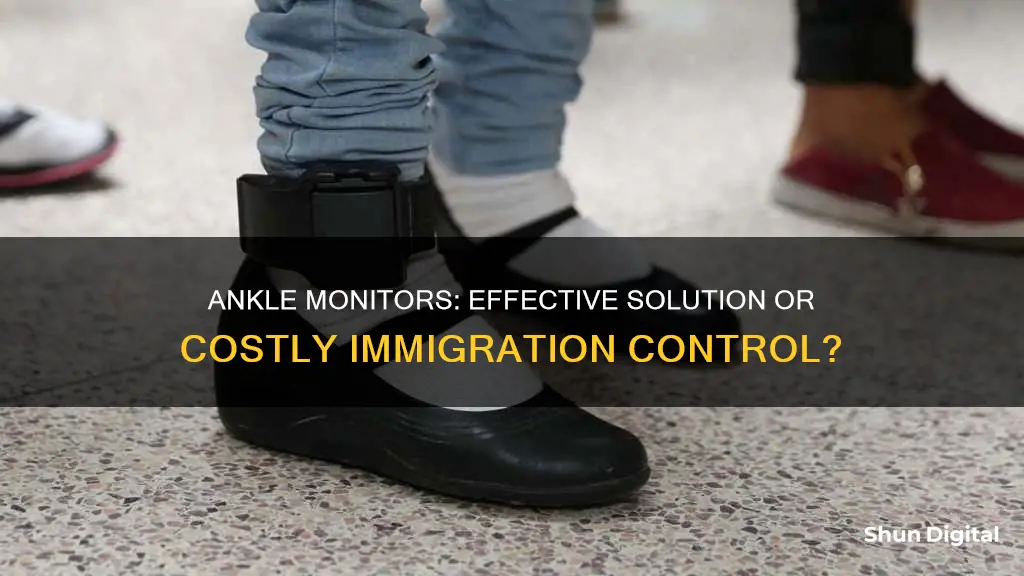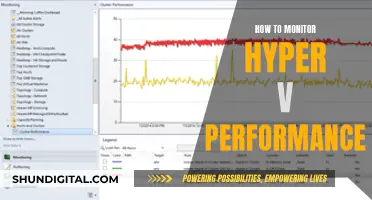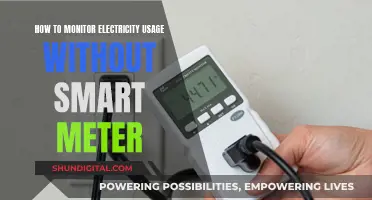
The use of ankle monitors on migrants has gained attention in recent years, particularly in the United States, as a way to track and monitor their movements. Ankle monitors, often referred to as electronic shackles by immigrants, are used by Immigration and Customs Enforcement (ICE) as an alternative to detention for those who are not considered flight or safety risks. While this approach aims to reduce the number of immigrants detained in facilities, it has raised concerns about the impact on the wearers' physical and mental health, their freedom of movement, and their employment prospects.
What You'll Learn
- Ankle monitors are used to track families with asylum claims
- They are also used to monitor those awaiting court or deportation
- The use of ankle monitors is cheaper than detaining immigrants
- They have been criticised for their negative physical and psychological impacts
- Ankle monitors also carry a significant social stigma

Ankle monitors are used to track families with asylum claims
Ankle monitors are being used to track families with asylum claims in the US. This is part of the Biden administration's approach to monitoring migrant families at home while also processing them for potential deportation. The use of ankle bracelets is an alternative to detaining families in jails or releasing them to wait years for their turn in immigration court.
The Family Expedited Removal Management (FERM) program uses GPS monitoring to track families with asylum claims. As of September 2023, there were more than 600 family units in the FERM program. The program is only available to families from certain countries, including Guatemala, Honduras, El Salvador, Peru, Ecuador, and Colombia, as they can be removed quickly. Families from countries with strained relationships with the US, such as Venezuela, Cuba, Senegal, India, and Nepal, do not qualify for the program.
For families that qualify, the head of the household receives a tracking device, such as an ankle monitor, and a phone that allows them to be tracked and connect with immigration officers. Some regions are transitioning to smartwatches that will eventually replace the phone and ankle bracelets. The FERM program also includes a curfew, regular check-ins with immigration officers, and geographical limits.
The use of ankle monitors as an alternative to detention (ATD) has gained attention as a more cost-effective and humane way to monitor immigrants. In July 2018, over 38,000 immigrants were fitted with ankle monitors, and by September 2022, the number of people in ICE's ATD program crossed 300,000 for the first time. Ankle monitors ensure supervision by immigration authorities and have proven to be highly effective in ensuring immigration court attendance, with many programs exceeding 90% success rates.
However, there are concerns about the negative impacts of ankle monitors on those wearing them, including physical and psychological effects, social stigma, and limitations on employment opportunities. Additionally, there are privacy concerns about the data collected through electronic monitoring and how it is used by immigration authorities.
Monitors: Rapid Growth to Full Size, How Quick?
You may want to see also

They are also used to monitor those awaiting court or deportation
Ankle monitors are used by the U.S. Immigration and Customs Enforcement (ICE) to track the location of immigrants. The ICE's Alternative to Detention (ATD) program has seen increased use in recent years, with nearly 41,000 people being monitored through GPS ankle bracelets in 2022. This program is intended to be a middle ground between detaining families in jails or releasing them to wait years for their turn in immigration court.
The use of ankle monitors is also a cost-saving measure, with the ICE spending over $200 per day to detain someone in immigration detention, and even more for families. In contrast, low-cost ATD programs like community supervision or electronic monitoring can cost as little as $4.50 per day.
ATDs have been proven to be highly effective in ensuring immigration court attendance, with many programs exceeding 90% success rates. They are also used to monitor those who are awaiting deportation. For example, in 2020, ICE was using ankle monitors to track persons who were either in removal proceedings and awaiting court, or being supervised after an order of removal had been entered.
The Biden administration has also been using ankle monitors as part of the Family Expedited Removal Management (FERM) program to monitor migrant families as part of a process to eventually deport them. This program includes a curfew for participants, who must be at home between 11 p.m. and 5 a.m. They are also required to regularly check in with an immigration office or case manager.
Removing ViewSonic VS16770 Monitor Base Stand: A Step-by-Step Guide
You may want to see also

The use of ankle monitors is cheaper than detaining immigrants
The use of ankle monitors on immigrants has been a growing trend in the United States in recent years. This method, known as an Alternative to Detention (ATD), gained attention as a more humane alternative to family detention, especially after the practice of separating immigrant families at the border was criticised in 2018.
ATDs, including the use of ankle monitors, have been found to be significantly cheaper than detaining immigrants. Immigration and Customs Enforcement (ICE) spends over $200 per day to detain a single person, and this cost increases when families are detained. In contrast, ATD programs can cost as little as $4.50 per day. This cost-effectiveness has not gone unnoticed, with Congress funding ATDs at $180 million in 2018, a substantial increase from the previous year.
The use of ankle monitors also frees up detention space for those who may pose a flight or safety risk. This allows authorities to focus their resources on individuals who may be more likely to abscond or cause harm. By employing ankle monitors for those who are neither a flight nor safety risk, the burden on detention facilities is reduced, and costs are kept lower.
While there have been concerns about the effectiveness of ATDs in ensuring immigrants appear for court proceedings, the majority of programs have achieved success rates above 90%. This high compliance rate further reinforces the argument that ankle monitors are a more cost-effective solution than detention, as it achieves the desired outcome without the high costs associated with detention.
In conclusion, the use of ankle monitors on immigrants is a cheaper alternative to detention. By utilising ankle monitors, authorities can save significant costs, free up detention space, and still achieve high compliance rates. While there are valid concerns about the impacts of ankle monitors on the wearers, the cost savings and other benefits present a strong case for their continued use as an alternative to detention.
Easy Steps to Mount Your ASUS IPS Monitor
You may want to see also

They have been criticised for their negative physical and psychological impacts
Ankle monitors have been criticised for their negative physical and psychological impacts on those who wear them. In the United States, the use of ankle monitors on migrants with children has been a particular point of contention, with the Biden administration attempting to monitor migrant families ahead of deportation. This has raised concerns about the human rights implications of such surveillance, especially when it comes to the physical and psychological effects on those being monitored.
One of the main criticisms of ankle monitors is the restriction they place on the wearer's movement. While the devices are intended to allow individuals to remain with their families and maintain employment, the reality is that they severely limit mobility. Michael Tafolla, a man from Chicago, recounted his experience with an ankle monitor after being released from prison. He described the challenges of adjusting his approved movement hours to accommodate an internship and a job, stating that he felt like he was "doing too much". The parole officer made him choose between the internship and the job, highlighting the restrictive nature of ankle monitors and their potential to hinder reintegration into society.
The physical discomfort caused by ankle monitors is another point of criticism. While modern devices have been designed with wearer comfort in mind, offering various sizes and styles, some individuals still experience discomfort. Shannan Davis, a Native American woman from Michigan, described her experience with an ankle monitor as stressful due to the device's tight fit. She mentioned that the cord wrapped around her leg and twisted into knots, causing discomfort when walking. This physical discomfort can add to the overall stress and anxiety of being monitored.
Ankle monitors have also been criticised for their psychological impacts. The stigma associated with wearing an ankle monitor can lead to social isolation and stress, exacerbating mental health issues such as depression and anxiety. Matthew Brown, a man from Arizona, shared his experience of being on an ankle monitor for three years. He described feeling disconnected from his family, especially those in Mexico, and mentioned the judgement he felt from others due to the visibility of the bracelet. The psychological effects of ankle monitors can be detrimental to the well-being of the wearer, impacting their mental health and sense of freedom.
Furthermore, the financial burden of ankle monitors can be significant. Fees for wearing these devices can range from $3 to $35 per day, in addition to initial setup charges. For individuals and families already facing economic challenges, these costs can be overwhelming. Matthew Brown expressed concern about the eventual cost of his ankle monitor, worried that the daily charges over three years could amount to a substantial sum. The financial strain caused by ankle monitors can lead to further stress and anxiety for those already dealing with the challenges of the legal system.
The negative physical and psychological impacts of ankle monitors have been well-documented, and critics argue that less restrictive measures should be implemented instead. The ACLU, for example, has called on jurisdictions to replace electronic monitoring with alternatives such as court reminders and transportation assistance.
LCD vs. LED Monitors: Which is Superior?
You may want to see also

Ankle monitors also carry a significant social stigma
Ankle monitors have been used as an alternative to detention for people involved with the immigration system. They are used to monitor people at home and track their location via GPS, enforcing house arrest or restricting movement within a certain radius. While the use of ankle monitors is intended to allow people to continue with their lives and reduce costs compared to incarceration, they also carry a significant social stigma.
The design of ankle monitors has not changed significantly in 30 years, with the devices remaining bulky and difficult to conceal. This makes the wearer's potential involvement with the justice system visible to others, marking them as someone to be shunned, spoken to disrespectfully, or treated as "other". The stigma associated with ankle monitors can lead to social isolation and stress, exacerbating depression and anxiety for wearers.
People wearing ankle monitors may curtail their activities due to the fear of being judged by others. For example, they may go out less often or alter their clothing to try to hide the monitor. The visibility of the monitor can also impact the wearer's ability to obtain and maintain employment, education, and housing. The limitations imposed by ankle monitors can make wearers vulnerable to judgment and discriminatory treatment, compromising their privacy and opportunities to form strong social bonds within their communities.
The use of ankle monitors has been linked to a historical tradition of shaming and marking individuals as criminals. This deliberate stigmatization is consistent with other aspects of criminal justice, such as mug shots, handcuffs, or public registries. However, unlike other forms of stigmatization, ankle monitors are not hidden behind record-access rules or restricted to specific moments such as arrest or transportation. Their constant visibility in daily life creates conditions for potential prejudice and discriminatory treatment.
Monitor Data Usage: Simple Tips for Combating Overage
You may want to see also
Frequently asked questions
Ankle monitors are used as an alternative to detention for immigrants who are not considered a flight or safety risk. They are also used to monitor those in removal proceedings and awaiting court, or being supervised after an order of removal has been entered.
Ankle monitors are more cost-effective than detention, with low-cost monitoring programs costing as little as $4.50 per day compared to over $200 for detention. They also ensure high rates of compliance for court appearances, with many programs exceeding 90% success rates.
Ankle monitors have been reported to cause physical issues such as inflammation, severe cramps, bleeding, sores, and numbness, as well as psychological effects. They also carry a significant social stigma, with wearers expressing feelings of being imprisoned. The stigma limits employment opportunities for immigrants, and the devices also impose restraints on their freedom of movement.







